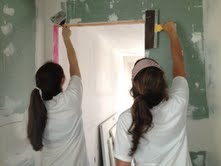March 30, 2012
Our closing ritual was a perfect ending for the trip. One of
our site supervisors, Nicole came with her boyfriend Trevor. The evening included performances, reflection
and gift giving. The performances were Laila doing one magic trick, our 4 Shenanigans singing 2 songs in perfect and beautiful harmonies, and Trevor playing Amazing Grace on the hand whistle. (hard to explain but pretty amazing.) Gifts included several funny poems, cards for everyone in the
group, a house of cards with its own house of cards blog and St. Bernard’s t-shirts
for everyone. There was much laughter
and appreciation. For our reflection
everyone wrote things they learned and a takeaway from the trip on an index
card. We leave you with those lists:
Things we learned:
How to
apologize without continuing to place blame on the other person
The
Mississippi River moves
How to dry
wall and mud and the importance of each step of construction
That some
people believe that the levies were purposely blown up in order to divert water
from the French Quarter in the lower 9th ward
How to mud
A lot of
interesting stories about people who lived through the hurricane
The amount
of devastation from Katrina
How to sand,
skim and prime dry wall
Alligator
tastes great
How to mud
and sand and how important it is
How to draw
Massachusetts
About the
culture in rural Louisiana
Rookies can
learn mudding pretty quickly
How to
mud/sand/float/skim
What a house
looks like beneath the paint
Some new
Taylor Swift songs
People
really do wrestle Alligators
What YOLO
means
How to build
a house
How to put
aside past problems with people
Southern culture
History of hurricane
Katrina
How to mud
with Nicole, it was great and I’m really appreciative
I am a lot
more capable with a 6 inch knife than I thought
Southern manners
The
importance of showing you care
How to mud
Conspiracy theories
about levies
About bayous
and alligators
How to love
That Jews
have lived in NO for many generations
From Laila
that to love someone is to tserve them and to serve someone is to love them
I also
learned that acceptance is an important part of love
About Jean
and James’ story and past
How much
goes in to creating a home…something I will no longer take for granted
How to do
things that I never knew I could do
Building a
house is harder than it looks.
Things we are taking away from the
experience:
That giving
my time and doing community service make not only a physical impact, but also a
mental impact on the people who are being helped.
Many
memories, some good, some bad but overall a great experience.
Hardwork –even
if something is deemed annoying or painful, can make normal activities seem
sweeter.
To always
cherish my house and family
To always
share love and acceptance whether appreciated or not
That people’s
connections to their homes can run deep and beyond the rational
I hope to
always take pride in my physical place ant that of others
Every moment
is a YOLO moment
To consider
being an Americacorps volunteer
To think
about people like Theresa
There is a
way to balance doing what is right and what is helpful with what is fun to do
After
hearing real stories, I am now convinced that this project is worthwhile. I needed to meet real victims in order to
feel really close to the project.
I will build
houses with my dad now because he does that for fun
There are
more important things than my own immediate gratification because in the long
run, the fact that I am helping someone is most important
Houses are
hard to build
People are
really grateful for what we did here
The need is
great, the flesh is weak, attitude makes the difference
Helping
means a lot. Not just giving money but
the fact that we are willing to give up time to come down and help out shows
people that other people care about them.
The
importance of physical service as opposed to monetory contribution. They don’t mean to reach the same end. They
may be related but actually serve totally different purposes.
Southern culture
is awesome and I have a new appreciation for the South
Everyone
needs a home
Every little
bit of work helps and a lot of help is needed
Everybody
deals with tragedy in different ways and that sometimes it is hard for others
to understand
We need to
help the victims of Katrina and victims of hurricanes no matter how long it
takes and no matter who is to blame
How many
complex questions, community service raises.
Sometimes
the most meaningful things in life are those that we already know a lot about.


































.JPG)
